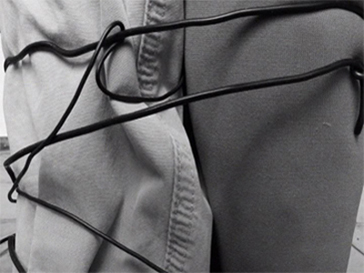
Born in 1934 in Lisbon (PT)
Lives and works in Lisbon (PT)

2010
Video, black & white, sound
Durée: 18'
Year of Purchase: 2011
Although they appear more introverted than other 1970s performances, Helena Almeida’s actions are not entirely solitary. The least active among them are no doubt marked by the isolation of the atelier where the Portuguese artist has been systematically designing, choreographing, and photographing her actions for over 40 years. Some images show her, for example, propped on a stool, “flying” flat on her stomach with her arms outstretched, or standing on her tiptoes, with her head thrown back. The flight attempt in Voar (Flying, 2001) is not unique, but whereas normally it has been employed in the service of the positive rhetoric of ascension, the lethargic Almeida imitates a glider’s flight at low altitude in her workshop which she hardly leaves. This indoor version contrasts with the conquering spirit of more masculine projections performed in the open air: in 1970, the Italian Gino de Dominicis was jumping off a bluff, while already in 1959, Yves Klein simulated an urban take-off in his famous photomontage Leap into the Void. Almeida discreetly alludes to the latter artist in her older black and white photographs in which, in sober attire, she seems to be swallowing blue smudges painted on the surface of the image. It’s an irreverent tribute to the famous blue which Klein used to smear over his nude models instrumentalized as female paint brushes in Anthropometries. Almeida prefers to imbibe the color, thus literally performing the critical act of devouring advocated by Oswald Andrade in his 1928 Cannibalist Manifesto. The Brazilian poet was recommending the incorporation of the colonizer’s otherness—in the case of Almeida, of the masculine predecessor—by symbolically ingesting him.
Always alone before the lens, Almeida addresses an implicit, but omnipresent, third person. Is the artist’s penchant for introspection no more than a response to the intersubjectivity invoked by certain titles: Feel me, Hear me, See me (1979). The furtive other is the mirror reflection and the reverse angle utilized in some images, but it’s also the eye of the photographer who has been capturing the artist from the very start: her husband, the architect Arturo Rosa. The usually invisible accomplice has recently started making an appearance, without, however, any hint of autobiography, since the artist rejects the very idea of self-portrait. Both their faces are thus cut in the video Untitled (2010) which frames only their legs. The static shot registers strange comings and goings: their legs are tied together with a wire which the artist tightens as it becomes undone. The annexation of the bodies creates three-legged Siamese twins, a limping duo held back by their obstinate joint exercise. The other is as much a burden as a support, and must be factored into this jerky choreography. The obstacle—voluntary servitude or reciprocal hostage-taking—guarantees their intimacy understood as a close relation between the individuals; however, it also cancels out the other facet of intimacy which is privacy. Assuming the reaffirmation of individuality through its dissolution in a “collective body,” similar couples have been around before: from the tender option of Lygia Clark’s binding her and Hélio Oiticica’s wrists with an elastic band, as a sort of sensuous handcuffs in the Hand Dialogue; to the radical option of Tehching Hsieh who was tied to Linda Montano with a rope wrapped around the waist for the entire year of 1983–84. Tending neither towards fetishism nor masochism, the act of binding draws here on the idea of a roped party of climbers, where Almeida literally holds on to her double who is constitutive of her own, ageing self, and whom she fears losing.
Hélene Meisel
1 Estudo para um enriquecimento interior, Study for inner improvement, 1977–78